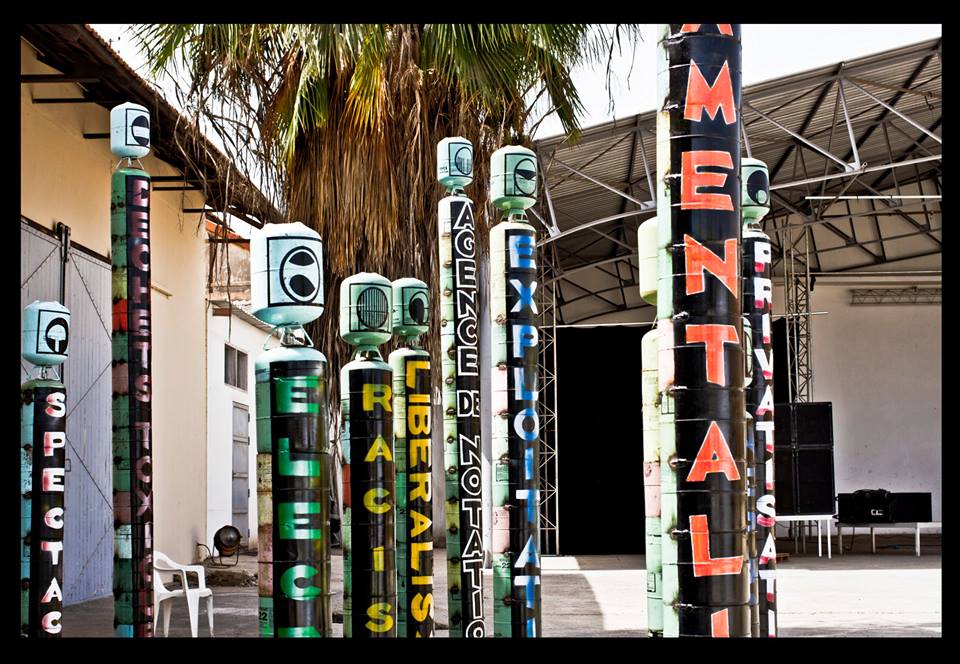Caroline Hancock takes a closer look at the Dak'Art 2014.

Dak'Art 2014 installation view. Image: Mame-Diarra Niang. © Mame-Diarra Niang
The local personalized colorful minibuses often seem to share the following painted inscription on either side of the vehicle: “TRANSPORT EN COMMUN.” Perhaps this was one of the influences for this years’ overall subject. The three guest curators of the international show at Dak’Art 2014, Elise Atangana, Abdelkader Damani, and Smooth Ugochukwu Nwezi, certainly seem to have worked in an exceptionally collaborative manner to produce this exhibition. Their various selections of artworks by 61 artists from Africa and the African diaspora are intermingled for the occasion in a vast warehouse complex called the Village on the rue de Rufisque. Media are highly diverse ranging from Tam Joseph’s contemporary classical paintings to Naziha Mestaoui’s high-tech interactive Body Resonance installation and Ato Malinda’s Mshoga Mpya (The New Gay) performance.
Outdoors, to set the tone, you are welcomed by Kiluanji Kia Henda’s caustic O.R.G.A.S.M. logo promoting an African N.G.O. bringing aid to Europe, and Justine Gaga’s 2012 gas cylinder installation titled Indignation. But then Joël Andrianomerisoa’s Jardin Sentimental, a monumental cotton and plastic black drape, dramatizes and/or conceals the entrance to the first of three large exhibition halls.
Dak’Art has always been pretty international but what this edition does emphasize interestingly is the diasporic richness of the artists related to the African continent and the infinite expansiveness of connections. Particularities and commonalities, as well as the spaces in between.
Works by international art stars like Kader Attia, Candice Breitz, Julie Mehretu, Wangechi Mutu, and Wael Shawky for instance are in dialogue with those by emerging or less well-known established artists. Jean Katambayi Mukendi talked about his philosophy of autonomy and indeed his enigmatic configurations remained audible and alive during the power cuts. Symbolically charged, Ismaïla Fatty’s karabulo-inspired hangings are physically close to Marcia Kure’s exquisite Three Graces which pay homage to great African figureheads – the Amazons of Dahomey, Ndlorukazi Nandi kaBebe eLangeni and Funmilayo Anikulapo-Kuti. Nidhal Chamekh’s intricate ink drawings and Milumbe Haimbe’s futuristic graphic novel could nearly share fantastical imagination with the extraordinary Soly Cissé sculptures and paintings presented in other exhibitions in the city. As do perhaps Chike Obeagu’s bustling collaged composition Cityscape and City Dwellers with Fatou Kine Aw’s paintings. Jean-Ulrick Désert titles his textile banners: The flutter of butterfly wings can trigger tornadoes around the world. Though seemingly discreet, Jimmy Robert’s printed photomontages Untitled (Skin) and Untitled (Visage) suggest profound interrogations, while archival footage, literature, and architecture are revisited in the film installations by Ali Essafi (North African Halakat) andAmina Menia (A Peculiar Family Album).
The collective impulse was to find culmination in an anonymous cabinet of curiosities space, a curatorial construct akin to Carolyn Christov-Bakargiev’s “Brain” in documenta 13. This section isn’t so cohesive since the allocated space is a very difficult one. But there are also gems here, like a version of Fayçal Baghriche’s collection of glass imperfections, some of Andrianomerisoa’s Sentimental products (TEA FOR 2 2 FOR TEA ME FOR U YOU FOR ME), John Akomfrah’s beautiful sandy installation echoing the Peripeteia film shown elsewhere in the exhibition and Houda Ghorbel’s strange sprouting clay heads.
The installation has a democratic air which doesn’t allow many works to sing over and above the others, and can cause a sense of clutter in parts – but that, of course, is not unusual in Biennale situations. The dynamism of the show comes from the variety of proposals and therefore its openness to differing, very personal receptions. More classical forms meet in the spaces with more cutting-edge proposals. These include different approaches to painting which are so relevant to the renowned Senegalese art history – thus creating clear bridges with other IN and OFF projects. Yet one can’t be sure how much consideration has really been given to the accessibility of the project by local audiences since its location, slightly away from the core centre and many other IN events, must reduce its chance of real popularity beyond the opening.
Nevertheless, the encounter itself, what it says about here and now, as well as what it opens up in terms of potentials, will certainly have an important place in the annals. During the opening conference, Simone Leigh movingly considered the invitation to this exhibition in Senegal and all its implications as a turning point in her practice. Julie Mehretu read some splendid notes including words such as “beat,” “symptomatic,” “premonition,” “mutant,” “mark making,” “pulsing”… Undoubtedly significant and signifying.
.
Caroline Hancock is an independent curator, writer and editor based in Paris.
More Editorial